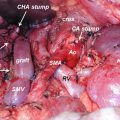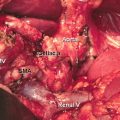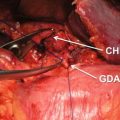Authors
Year
Study design
Procedure
Variable
Sample size
Morbiditya (%)
Pancreatic fistulab (%)
Re-drainage (%)
Reoperation (%)
Readmission (%)
Mortality (%)
Conlon et al. [11]
2001
RCT
PD and DP
Drain
88
22
12.5
13
9
NA
2
No drain
91
12
0
8
4
NA
2
Fisher et al. [12]
2011
Retrospective study
PD and DP
Drain
179
21
12
2*
4
9*
1
No drain
47
15
11
11
0
17
2
Mehta et al. [13]
2013
Retrospective study
PD
Drain
251
36.3
16.3
8.4
5.6
17.5
2.0
No drain
458
30.2
7.6*
6.3
5.7
16.8
2.5
Correa-Gallego et al. [14]
2013
Retrospective study
PD and DP
Drain
553
33
20
19
<1
27
1
No drain
569
26*
16*
15
<1
20*
2
Adham et al. [15]
2013
Retrospective study
PD and DP
Drain
130
29.4
9.2
14.6
NA
NA
5.4
No drain
112
42.9
11.4
20.5
NA
NA
4.5
van Buren et al. [16]
2014
RCT
PD
Drain
68
28
10
9*
3
16
3
No drain
69
41
20
23
9
12
12
It had remained still controversial whether routine intraperitoneal drains decrease the postoperative complications after pancreatectomy. In 2014, a multicenter randomized controlled trial in the USA has evaluated whether pancreaticoduodenectomy without routine intraperitoneal drains does not increase the incidence of severe postoperative complications [16]. One hundred thirty-seven patients who underwent pancreaticoduodenectomy were enrolled in this study; 68 patients were randomized to drain group, and 69 patients were randomized to no drain group. The primary endpoint for this a multicenter randomized controlled trial was the 60-day grade II or greater complication rate. This study has demonstrated that pancreaticoduodenectomy without intraperitoneal drainage was associated with increased 60-day grade II or greater complication rate, which was the primary endpoint for this a multicenter randomized controlled trial (drain group 52% vs. no drain group 68%, P = 0.047). Moreover, no drain in this study significantly increased gastroparesis (drain group 24% vs. no drain group 42%, P = 0.021), intra-abdominal abscess (drain group 12% vs. no drain group 26%, P = 0.033), diarrhea more than grade II (drain group 3% vs. no drain group 17%, P = 0.005), abdominal fluid collection (drain group 2% vs. no drain group 12%, P = 0.033). The most important point was that the study was stopped early by the Data Safety Monitoring Board although this study were planned to require a total of 752 patients for the two groups at first. Because mortality in no drain group was 12% which was a fourfold increase compared to 3% in drain group after 90-day follow-up. This study concluded that pancreaticoduodenectomy without intraperitoneal drainage significantly increased the incidence of severe complications and contributed to increased mortality.
36.3 The Impact of Early Removal Drain After Pancreatectomy
What is appropriate drain management after pancreatectomy? The period of drain insertion is the most important point regarding drain management after pancreatectomy. Table 36.2 summarized two studies which have reported the association between early drain removal and pancreatic fistula. One prospective study and one randomized controlled trial have been designed to clarify whether the intended period of drain insertion influenced postoperative complication rates after pancreatectomy. The study by Kawai et al. prospectively assigned the patients who underwent PD into two groups: group I (n = 52, drain to be removed on postoperative day (POD) 8) and group II (n = 52, drain to be removed on POD 4). The incidence of pancreatic fistula was significantly lower in POD 4 (3.6%) than in POD 8 (23%) (P = 0.0038) [17]. The incidences of intra-abdominal infections, including intra-abdominal abscess and infected intra-abdominal collections, were significantly reduced in POD 4 (7.7%) compared with POD 8 (38%) (P = 0.0003). Moreover, drain removal on POD8 was the only independent risk factor for intra-abdominal infections by multivariate analysis (odds ratio: 6.7). This study has concluded that postoperative complications rates including pancreatic fistula and intra-abdominal infections were significantly lower when the prophylactic drains were to be removed on POD 4.
Table 36.2
Studies to evaluate the association between early removal drain and pancreatic fistula
Authors | Year | Study design | Procedure | Variable | Sample size | Pancreatic fistulaa (%) | Intra-abdominal infection (%) | Reoperation (%) | Readmission (%) | Mortality (%) |
|---|---|---|---|---|---|---|---|---|---|---|
Kawai et al. [17] | 2006 | Prospective study | PD | Early drain removal on POD4 | 52 | 3.6* | 7.7* | 0 | 0 | 0 |
Late drain removal on POD8 | 52 | 23 | 38
Stay updated, free articles. Join our Telegram channel
Full access? Get Clinical Tree
 Get Clinical Tree app for offline access
Get Clinical Tree app for offline access

|



